Advertisements
Advertisements
Question
Base of a triangle is 9 and height is 5. Base of another triangle is 10 and height is 6. Find the ratio of areas of these triangles.
Solution 1

Let ABC and PQR be two right triangles with AD ⊥ BC and PS ⊥ QR.
BC = 9, AD = 5, PS = 6 and QR = 10.
The ratio of areas of two triangles is equal to the ratio of the products of their bases and corresponding heights.
`("A"(Δ"ABC"))/("A"(Δ"PQR")) = ("AD" × "BC")/("PS" × "QR")`
∴ `("A"(Δ"ABC"))/("A"(Δ"PQR")) = (5 × 9)/(6 × 10)`
∴ `("A"(Δ"ABC"))/("A"(Δ"PQR")) = 3/4`
Hence, Ratio of Area of △ABC : Area of △PQR = 3 : 4.
Solution 2
Let the base, height, and area of the first triangle be b1, h1, and A1 respectively. Let the base, height and area of the second triangle be b2, h2, and A2 respectively.
b1 = 9, h1 = 5, b2 = 10 and h2 = 6.
The ratio of areas of two triangles is equal to the ratio of the products of their bases and corresponding heights.
`("A"_1)/("A"_2) = ("b"_1 × "h"_1)/("b"_2 × "h"_2)`
∴ `("A"_1)/("A"_2) = (9 × 5)/(10 × 6)`
∴ `("A"_1)/("A"_2) = 3/4`
The ratio of the areas of the triangles is 3 : 4.
RELATED QUESTIONS
In the following figure seg AB ⊥ seg BC, seg DC ⊥ seg BC. If AB = 2 and DC = 3, find `(A(triangleABC))/(A(triangleDCB))`

The ratio of the areas of two triangles with the common base is 14 : 9. Height of the larger triangle is 7 cm, then find the corresponding height of the smaller triangle.
The ratio of the areas of two triangles with common base is 6:5. Height of the larger triangle of 9 cm, then find the corresponding height of the smaller triangle.
In the given figure, BC ⊥ AB, AD ⊥ AB, BC = 4, AD = 8, then find `("A"(∆"ABC"))/("A"(∆"ADB"))`
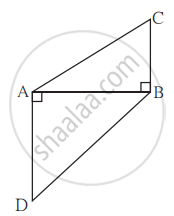
In the given figure, ∠ABC = ∠DCB = 90° AB = 6, DC = 8 then `("A(Δ ABC)")/("A(Δ DCB)")` = ?
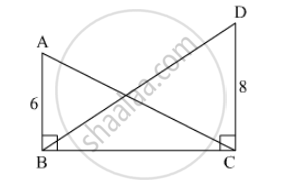
In the figure, PM = 10 cm, A(∆PQS) = 100 sq.cm, A(∆QRS) = 110 sq. cm, then find NR.
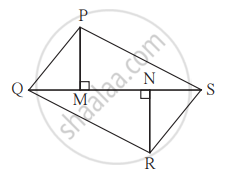
In ∆ABC, B – D – C and BD = 7, BC = 20, then find the following ratio.
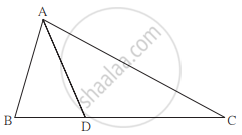
`(A(∆ABD))/(A(∆ABC))`
In ∆ABC, B – D – C and BD = 7, BC = 20 then Find following ratio.
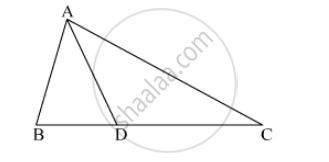
\[\frac{A\left( ∆ ADC \right)}{A\left( ∆ ABC \right)}\]
In the given, seg BE ⊥ seg AB and seg BA ⊥ seg AD.
if BE = 6 and AD = 9 find `(A(Δ ABE))/(A(Δ BAD))`.
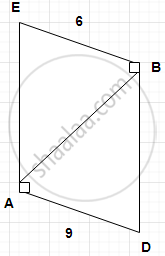
A roller of diameter 0.9 m and the length 1.8 m is used to press the ground. Find the area of the ground pressed by it in 500 revolutions.
`(pi=3.14)`
In fig. BD = 8, BC = 12, B-D-C, then `"A(ΔABC)"/"A(ΔABD)"` = ?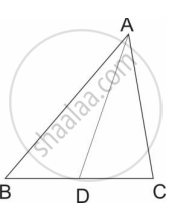
In fig., PM = 10 cm, A(ΔPQS) = 100 sq.cm, A(ΔQRS) = 110 sq.cm, then NR?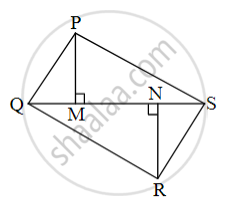
ΔPQS and ΔQRS having seg QS common base.
Areas of two triangles whose base is common are in proportion of their corresponding [______]
`("A"("PQS"))/("A"("QRS")) = (["______"])/"NR"`,
`100/110 = (["______"])/"NR"`,
NR = [ ______ ] cm
In fig., AB ⊥ BC and DC ⊥ BC, AB = 6, DC = 4 then `("A"(Δ"ABC"))/("A"(Δ"BCD"))` = ?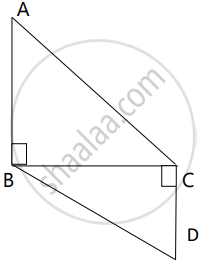
Prove that, The areas of two triangles with the same height are in proportion to their corresponding bases. To prove this theorem start as follows:
- Draw two triangles, give the names of all points, and show heights.
- Write 'Given' and 'To prove' from the figure drawn.
In the figure, PQ ⊥ BC, AD ⊥ BC. To find the ratio of A(ΔPQB) and A(ΔPBC), complete the following activity.
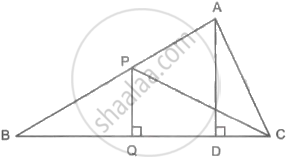
Given: PQ ⊥ BC, AD ⊥ BC
Now, A(ΔPQB) = `1/2 xx square xx square`
A(ΔPBC) = `1/2 xx square xx square`
Therefore,
`(A(ΔPQB))/(A(ΔPBC)) = (1/2 xx square xx square)/(1/2 xx square xx square)`
= `square/square`
